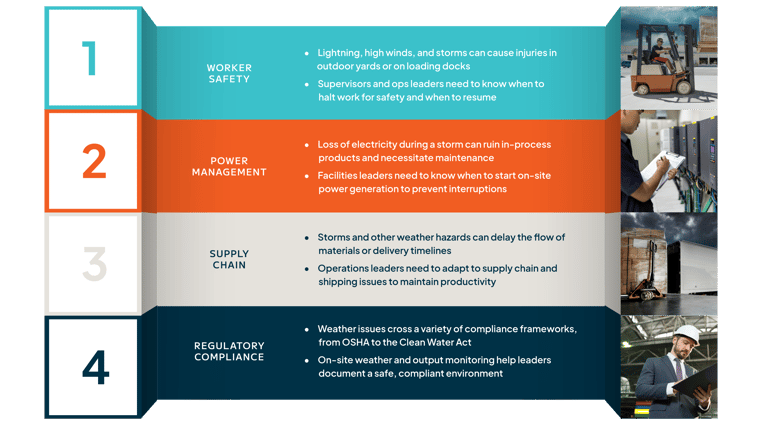
As a manufacturer, staying ahead of the curve when it comes to weather is key to ensuring business continuity, meeting regulatory requirements, and keeping employees safe. Unfortunately, extreme weather events are on the rise, and with them come unique challenges that manufacturers must face.
Moving forward, we will...
- Identify the key weather challenges for operations and safety leaders in the manufacturing sector
- Explore how innovative manufacturers are using weather technology and services to overcome those challenges
- Uncover how manufactures can connect with the resources they need to rapidly improve their approach to weather operations and risk management
Weather challenges for manufacturers
1. Worker Safety
Lightning, precipitation, heat, wind, and other extreme weather in the yard or at the loading dock can endanger workers and products. If you are a manufacturer, it's important to have a comprehensive safety plan that takes weather events into account. This plan should include safety protocols for both your employees and your equipment.
For example, if a lightning storm is approaching, workers should be directed to move indoors and away from any metal structures or equipment that could conduct electricity. In addition, all outdoor equipment should be properly secured or moved indoors to prevent damage or accidents.
2. Power Management
Weather-related power outages can be costly for manufacturers. That's why it's key to have onsite generation capabilities. Operations and facilities managers in factories need to know when to turn their industrial generators on before a weather-related power failure occurs.
If generators are not started in time, the power may go out, leading to product loss, costly equipment maintenance, and downtime. On the other hand, if the generators are started prematurely, they only increase operating costs.
3. Supply Chain Management
Weather can have a significant impact on the flow of materials into a manufacturing facility or on order fulfillment once products leave the production facility. Over the last five years, climate variability, COVID-19, and global conflict have made global shipping far less reliable, and many suppliers around the world are still struggling to adapt to the new reality.
Those challenges have made the entire industry feel less reliable: less reliable supply means less reliable production means less reliable profit.
4. Regulatory Compliance
Manufacturers are beholden to both OSHA and Clean Water Act regulations, among others. Demonstrating to regulators that workers are safe and the business is having a responsible impact on the environment are just as important as doing those things. Lack of clear policy, measurement, and documentation can make it difficult to get permits or even result in major fines.
How can manufacturing facilities overcome growing weather challenges?
Hyperlocal custom forecasting
Custom forecasting services are a boon to operations and safety leaders in the manufacturing industry. They offer a crucial edge in the ever-evolving world of manufacturing, where precision, efficiency, and risk management are key.
On-demand forecasting services help identify potential risks and disruptions in the manufacturing process, enabling operations leaders to adjust and adapt accordingly. In an industry where a single hiccup can cause significant financial and operational setbacks, being able to foresee and mitigate these challenges is invaluable. These services allow leaders to take proactive measures, ensuring the smooth running of operations and safeguarding against unforeseen circumstances.
Custom forecasting services are not just a tool, but a strategic ally for operations and safety leaders in the manufacturing industry. They empower these leaders with data and insights, allowing them to make informed decisions, manage risks, and stay attuned to customer behavior.
Real-time storm tracking
Real-time storm tracking provides leaders with the critical data they need to protect their most valuable assets: their employees and equipment. By tracking storms in real time, leaders can take proactive measures to ensure the safety of their workforce and protect physical assets. Real-time insights can help trigger timely interventions like employee evacuations, securing outdoor equipment, or implementing emergency safety protocols.
Secondly, real-time storm tracking enables effective resource planning and management. In the face of a looming storm, leaders need to make quick decisions about production schedules, supply chains, and logistics. Real-time data allows them to adjust these elements dynamically, perhaps by deferring certain operations or rerouting shipments to avoid storm-affected areas. This can help minimize disruption and maintain operational continuity, even under challenging weather conditions.
Real-time storm tracking is more than just a technical advantage for operations and safety leaders at manufacturing facilities. It's a strategic asset that enhances safety, enables effective decision-making, and promotes resilience in the face of severe weather events. As such, it's an indispensable tool in the modern manufacturing landscape.
Onsite monitoring
Both OSHA and the CWA have stringent requirements regarding workplace safety and environmental protection. Real-time weather monitoring can help manufacturers meet these standards and avoid costly penalties.
For instance, OSHA requires employers to provide a safe working environment. By monitoring weather conditions and taking appropriate actions, manufacturers can demonstrate their commitment to this requirement.
Similarly, the CWA imposes strict rules on water pollution. Severe weather events, particularly storms, can lead to runoff from manufacturing sites, potentially polluting nearby water bodies. With onsite weather monitoring, manufacturers can anticipate such events and implement measures to prevent water contamination, such as diverting runoff or storing potentially hazardous materials securely.
Work with a weather expert who understands the manufacturing space
Extreme weather events are becoming more common and pose unique challenges to manufacturers. However, with a little bit of preparation and planning, manufacturers can stay ahead of the curve and minimize the impact of weather on their operations. Whether it's ensuring worker safety, managing power systems, adapting supply chain management, or complying with regulatory requirements, manufacturers have a range of tools and strategies at their disposal to weather the storm.
If you are a safety or operations manager in manufacturing looking to stay ahead of the curve, it's time to talk to AEM about getting the weather intelligence you need.


